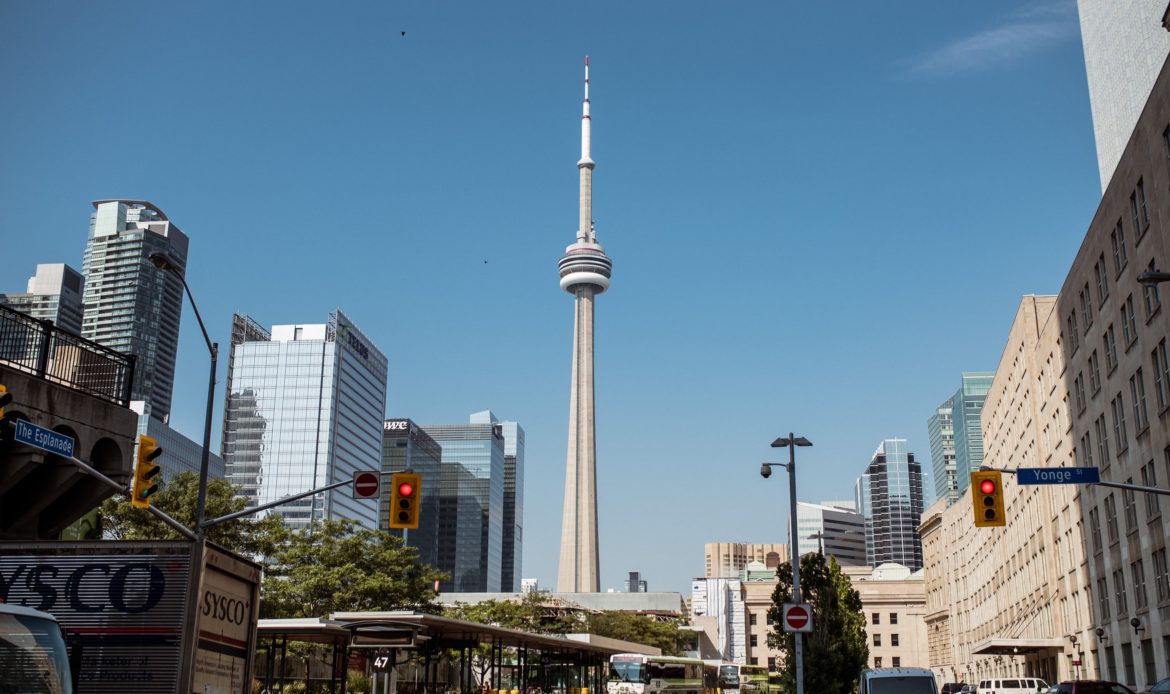This City Sometimes Feels Like A Movie Set
Film experts and industry professionals on Toronto’s growing film industry

Jason Mamoa was spotted eating at the exact same burger place that I eat at in between shoots of season 2 of See (2019-present). I carpool to ringette with a woman who played a background Commander’s Wife on Hulu’s The Handmaid’s Tale (2017-present). Kiefer Sutherland filmed a scene for Designated Survivor (2016-2019) right outside of my dorm on a rainy spring day during my freshman year. Often, when I go jogging on the University of Toronto (UofT) campus, I have to squeeze between the trailers that line Devonshire Place. For a brief period of time in the summer of 2021, I kept running into filming of DC’s Titans (2018-present) whenever I was in a rush to get somewhere, not unlike a rival in an old Pokémon game. The other day I saw my own apartment in the background of a TV show I was watching.
While the Toronto International Film Festival (TIFF) puts a worldwide spotlight on film in Toronto for ten days every September, the industry itself is at work here around the clock and the calendar. In fact, Toronto is one of the top five screen-based production centres in North America, investing $2.2 billion in the Toronto economy in 2019 through 30,000 jobs, 1,500 projects, and 7,600 productions. Even with COVID-19 slowdowns, the industry still contributed $1.5 billion to the province in 2020.
“[The industry] has grown exponentially,” said actress Theresa Tova in an interview with The Innis Herald; Tova has been working in the city since the late 1970s. “There’s a way to make a living here. You don’t have to go to the States anymore. There’s so much opportunity,”
Toronto remains the centre of English Canadian productions, but has also become a destination for the American film industry since the 1970s-1980s and has been growing since. The city’s chameleon-quality plays a role in this growth: “where we’re located geographically… where we’re located culturally… language and to some extent, our demographics and it’s very easy to make us pretend to be the US,” stated Adam Nayman, a film critic and professor at UofT’s Cinema Studies Institute (CSI), in an interview with The Innis Herald. The weaker Canadian dollar also contributes, which can make a considerable difference when you are working on a project totaling in the millions. Between 1975 and 1982, dubbed the “tax shelter era,” filmmakers could deduct their entire investment from their taxable income as long as it was largely produced and post-produced in Canada. Significant tax incentives remain today.
Toronto also has a wealth of talent in front and behind the camera as well as in post-production positions, particularly as more and more crew members were needed for American productions. “What happened over time, basically through piecemeal investment and government subsidies… It built up a group of people who were film professionals,” Bart Testa of the CSI told The Innis Herald. “The facilities and the craftspeople and the technicians were there and ready to go and were pretty experienced, and they weren’t unionized in quite the same rigid way and the same expensive way that they were in New York and Los Angeles.”
“The profile of shooting in Canada in Toronto in particular, as that reputation grew, so did TIFF’s… they were getting more and more high-profile movies that wanted to open at this festival in Toronto, and at the same time Toronto was getting bigger productions to work on,” Glen Gauthier of Toronto’s International Alliance of Theatrical Stage Employees (IATSE) office told The Innis Herald; Gauthier has been working behind the scenes of Toronto’s film industry since 1974. “I think they were tied together.”
TIFF brings actors and industry members to experience the city. The festival’s programming includes business forums that allow stakeholders in Toronto the time and space to convince visiting professionals to form partnerships and shoot their productions here. “In the past 10-15 years, with the city on the map for all these production studios to see Toronto and spend time every single year here and kind of like acclimatize themselves to ‘Oh, it’s not that far. Oh, it is such a North American cosmopolitan city,’” stated Magali Simard, the Program Manager of Film Sector Development at the City of Toronto, in an interview with The Innis Herald. “And that’s when the city started selling itself: ‘Oh, you don’t just need to come make deals 10 days a year.’” Industry members and stars were also attracted to the vibrant city life they experienced while visiting.
In 2017, Toronto was named a Creative City of Media Arts by the United Nations Educational, Scientific and Cultural Organization (UNESCO) because of its leadership in film, digital media and other forms of cultural expression. “For those who travel a lot, it’s one thing to travel but it’s another thing to travel to cities that are going with art, culture and entertainment, that’s where the pulse of who people is,” said Simard. “People here get to live it every single day and, as much as they wish, to engage with it in a hopefully organic way.”
Toronto’s film industry is only expected to grow in the coming years. “The next five years is huge, the global production volumes are bigger than ever,” stated Simard. “We all know that the streamers have changed the game.” According to Simard, Toronto is expanding its studio space by approximately 60% over the next five years, about two million square feet, after years of turning away projects totalling up to $100 million due to capacity limits of their current studio space.
Gauthier hopes that the COVID-19 pandemic will have positive effects on the future of Toronto’s film industry, as it showed that shoots can be completed in ten hours. Gauthier explained that in recent years production dates have gotten shorter while individual days have gotten longer, sometimes totalling fifteen hours. Technological advances have caused more staff to be needed on site to get the same amount of work done, putting pressure on production budgets as each additional day of shooting becomes more expensive.
…Maybe I Can Be An Extra At Least

A sentiment echoed through interviews with experts and industry professionals was the ease at which this city could masquerade as another. In popular films, it seems that Toronto is everywhere but here.
Take for instance my old rival, Titans, where iconic spots around the city pose as locales for a multitude of American cities. In Titans, Sonic Boom and neighbouring Dark Horse Coffee on Spadina are two unconnected San Francisco storefronts. Emsley Place’s Historic Houses – residence buildings of St. Michael’s College – and the bridge next to Brennan Hall double as Washington, D.C. Kensington’s iconic Victorian-style buildings are supposed to be located in Gotham. Most egregiously, Casa Loma serves as the outside of Wayne Manor.
“Canada is not on the radar of American culture,” explained Testa. “And that’s just the way it is. Even though Margaret Atwood wrote The Handmaid’s Tale – she’s a famous Canadian author – she placed almost that entire story in the United States… Canada’s only role is the place you can go which isn’t crazy like the United States.” Simard expressed more hope: “this amazing cosmopolitan city that we’ve become over the years really makes it an attractive place, increasingly… So I think it’s a lot of elements that may get eventually like, not just Torontonians wanting to tell Toronto stories but others wanting to back them up and be interested in doing that, so we’ll see what the years ahead bring.” She pointed to Pixar’s 2022 feature Turning Red, directed by Sheridan College graduate Domee Shi, set against the backdrop of early 2000s Toronto.
Toronto has historically had a vibrant independent movie scene pre-existing and then running parallel with the mainstream film industry, starting with the development of underground/subversive independent productions in the 1970s. “The eighties would be synonymous with the Toronto New Wave, which is a young vital indie-minded artisanal school of filmmakers,” said Nayman. “They make movies that are kind of about Toronto culture, and that stream continues and deepens and diversifies through the nineties and the two-thousands.” Ron Mann, a filmmaker of the Toronto New Wave and an Innis College alumnus, explained in an interview with The Innis Herald that “these were a group of people who are the same generation, like the same age, and who all were friends, played baseball together. But had completely different artistic visions, but we all worked on each other’s films.”
Mann emphasized that Canada still offers a lot of support programs for independent filmmakers, at least relative to the United States. It is distributing these films widely that raises issues. Nayman pointed to the flattening effect of franchise films in the post-Star Wars era, leaving critics less space to dictate the market share of films. “Marvel can tell you what you’re going to be watching in March of 2025, and you have no choice in the matter because that’s what’s going to play on 4000 screens, it’s four years away, but it’s planned,” he explained. “What chance do smaller films, Canadian or otherwise, really have except for people who are sort of the self-selecting group that knows that they’re going to go see them and patronize them.” The closure of more and more of the independent movie theatres that show Canadian productions and the dominance of streaming services uninterested in the independent sector have also played a role.
Despite its location, Torontonian stories are also rare at TIFF. Of 176 new films shown at TIFF, 20.4% were at least partially produced in Canada, almost half of which – or 9.1% total – were in the Short Cuts section. Seven of said films were produced and take place in or around Toronto – in part or in full – including three documentaries, one short film and three in the Discovery category for new filmmakers. This is noteworthy, as film festivals offer the opportunity for filmmakers to screen their movies, but also to partake in networking, marketing and exposure. “One of the key things film festivals have the power to do is provide a platform for films and filmmakers that don’t have the support of distributors and marketing campaigns behind them,” stated Anna Bogutskaya of the Underwire Festival UK in an interview with Screen Daily in August 2016. In the same interview, Lucy Fisher of the Gold Coast Film Festival explained that “film festivals have many roles in the 21st century – discovery of great films, making films accessible, curation of films for audiences, opportunities for industry.”
Even without changing their programming to be more Toronto-oriented/inclusive, there are other ways to bring wider awareness to Toronto’s stories. TIFF is currently partnered with festivals that share South African, Palestinian, Irish, Iranian, Italian, Brazilian and Korean cinema, but none that focus specifically on Torontonians. Perhaps if TIFF used their tremendous platform to bring the many stories of our city to the wider film industry and world, we would find ourselves on the United States’ radar and projects set here would become more palatable.
Or perhaps not. Perhaps the popular films emerging from Toronto will continue to be in service of what Testa refers to as a “narcissistic country” in the United States. “The good thing is,” Mann said, “Filmmakers will make films no matter what.”
